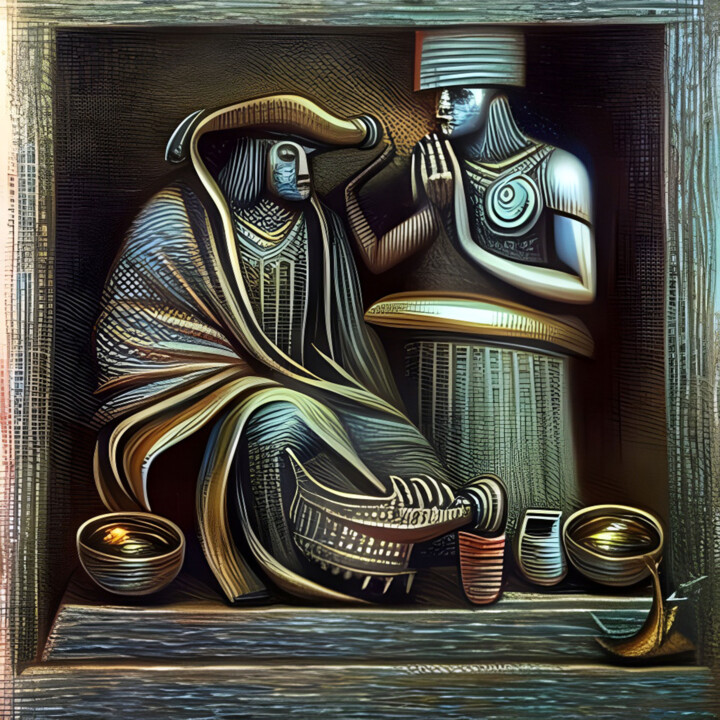"Fine-Arts" prints on paper
It is a process of printing on art paper using very high-quality pigment inks and printed in very high definition. Its level of conservation is exceptional (more than 100 years), its quality, depth, and richness of nuances exceeds the classic photo print on Argentic paper.

Glossy finish
Apart from its exceptional thickness, the fiber paper is composed of an alpha-cellulose base without acid and it is covered with barium sulphate, and a microporous layer absorption enhancing pigments during printing. A pure white color, non-yellowing to light, this paper is especially designed for resistance and aging. It is used by major museums worldwide as it offers excellent resolution, rendering deep and dense colors.
Art Print "Fine Art" - Glossy finish on a fiber base paper 325 g.

Our high end prints and reproductions
ArtMajeur only uses natural papers with neutral pH, resistant, and of high quality, selected from renowned papermakers!
Constant attention is paid by our master printer, whether in terms of color control or respect for the graphic chain. Our high level of quality requirement is a major asset of ArtMajeur framed art prints.
For Artists! You help artists to live from their work. They receive royalties everytime you buy their prints.
About our fine printsPurchase a license to use this image for your website, communications or to sell merchandise.
Usage: Web Licence
| 1500 px | ||

|
1500 px |
| Dimensions of the file (px) | 1500x1500 |
| Use worldwide | Yes |
| Use on multi-support | Yes |
| Use on any type of media | Yes |
| Right of reselling | No |
| Max number of prints | 0 (Zero) |
| Products intended for sale | No |
Download immediately upon purchase
This image is available for download with a licence: you can download them at anytime.
Restrictions
All images on ArtMajeur are original works of art created by artists, all rights are strictly reserved. The acquisition of a license gives the right to use or exploit the image under the terms of the license. It is possible to make minor modifications such as reframing, or refocusing the image so that it fits perfectly to a project, however, it is forbidden to make any modification that would be likely to harm the original work In its integrity (modification of shapes, distortions, cutting, change of colors, addition of elements etc ...), unless a written authorization is obtained beforehand from the artist.
Custom licences
If your usage is not covered by our standard licences, please contact us for a custom licence.
Art image bank-
This work is an "Open Edition"
Digital Arts,
Giclée Print / Digital Print
- Dimensions Several sizes available
- Several supports available (Fine art paper, Metal Print, Canvas Print)
- Framing Framing available (Floating Frame + Under Glass, Frame + Under Acrylic Glass)
- Artwork's condition The artwork is in perfect condition
- Categories Conceptual Art History
2500-3000 years ago, in the Middle East, codes of laws were the creation of people: whether they were kings, priests or sages.
Hammurabi's code is also the creation of the man whose name it bears.
Let us not forget that Hammurabi was also human, and the code he wrote was not a metaphysical creation.
The human origin of the Code is what this creation is meant to highlight.
Related themes
Born in Transylvania in a well-known family with roots going back centuries, all the way to 1204, as one of the founders of the 'Despotate of Epirus,' the author has been drawn to the Ancient Esoteric Teachings since childhood. He learned and practiced by himself what he could grasp from a diverse, sometimes disparate, yet highly controversial range of masters such as Helena P Blavatsky, Jiddu Krishnamurti, Rudolf Steiner, and even Piet Mondrian, the great Dutch painter.
Eventually, Eugene Matzota’s own writings were published and dully noticed - since 1997 he has been accepted as a full member of the International Theosophical Society, India.
During the past 20 years, he has published a number of four books on Theosophy and he is now busy at work on what he believes is his most important contribution.
Eugene Matzota founded his first newspaper in early 1990.
Since then, he has published hundreds or thousands of articles and held senior positions in many publications, most recently ALTCULTURE MAGAZINE, which he also founded.
Over the past 25 years he has created many illustrations for the publications he has edited, as well as separate creations, using over 30 years of computer experience.
His newest focus is creative work alongside AI, trying to overcome human and artificial barriers...
Some of his creations are presented here.
-
Nationality:
ROMANIA

- Date of birth : 1954
- Artistic domains:
- Groups: Romanian Contemporary Artists








